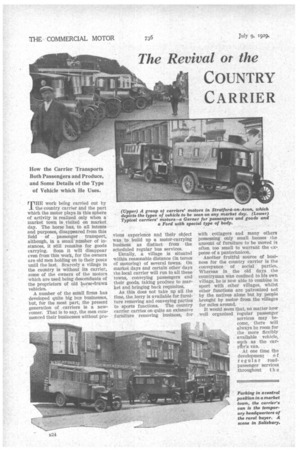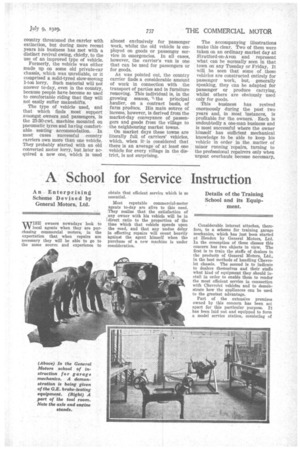The Revival or the COUNTRY CARRIER
Page 82

Page 83

If you've noticed an error in this article please click here to report it so we can fix it.
rp HE work being carried out by
the country carrier and the part which the motor plays in this sphere of activity is realized only when a market town is visited on market day. The horse has, to all intents and purposes, disappeared from this field of passenger transport, although, in a small number of instances, it still remains for goods carrying. Soon it will disappear even from this work, for the owners are old men holding on to their posts until the last. Scarcely a village in the country is without its carrier, some of the owners of the motors which are used being descendants of the proprietors of old horse-drawn vehicles.
A. number of the small firms has developed quite big bus businesses, but, for the most part, the present generation of carriers is a newcomer. That is to say, the men commenced their businesses without pre
vious experience and their object was to build up a motor-carrying business as distinct from the scheduled regular bus services.
Usually, a village is situated within reasonable distance (in terms of motoring) of several towns. On market days and certain other days the local carrier will run to all these towns, conveying passengers and their goods, taking produce to market and bringing back requisites.
As this does not take up all the time, the lorry is available for furniture removing and conveying parties to sports functions. The country carrier carries on quite an extensive furniture removing business, for with cottagers and many others possessing only small houses the amount of furniture to be moved is often too small to warrant the expense of a pantechnicon.
Another fruitful source of business for the country carrier is the conveyance of social parties. Whereas in the old days the countryman was confined to his own village, he is now able to combine in sport with other villages, whilst other functions are patronized not by the natives alone but by people brought by motor from the villages for miles around.
It would seem that, no matter how well organized regular passenger services may become, there will always be room for the more flexibly available vehicle, ,such as the carrites van.
At one time the
development o f regular roadpassenger services throughout t h e
country threatened the carrier with extinction, but during more recent years his business has met with a distinct revival owing, chiefly, to the use of an improved type of vehicle.
Formerly, the vehicle was either made up on some old private-car chassis, which was unreliable, or it comprised a solid-tyred slow-moving 1-ton lorry. Such material will not answer to-day, even in the country, because people have• become so used to comfortable riding that they will not easily suffer makeshifts.
The type of vehicle used, and that which finds most support amongst owners and passengers, is the 25-30-cwt. machine mounted on pneumatic tyres and having comfortable seating accommodation. In most cases successful country carriers own more than one vehicle. They probably started with an old converted motor lorry, but later acquired a new one, which is used
almost exclusively for passenger work, whilst the old vehicle is employed on goods or passenger service in emergencies. In all cases, however, the carrier's van is one that can be used for passengers or for goods.
As was pointed out, the country carrier finds a considerable amount of work in connection with the transport of parties and in furniture removing. This individual is, in the growing season, the principal haulier, on a contract basiS, of farm produce. His main source of income, however, is derived from the market-day conveyance of passengers and goods from the village to • the neighbouring market towns. On market days these towns are literally full of carriers' vehicles, which, when it is considered that there is an average of at least one vehicle for every village in the district, is not surprising.
The accompanying illustrations make this clear. Two of them were taken on an ordinary market day at Stratford-on-Avon and represent what can be normally seen in that town on any Tuesday or Friday. It will be seen that some of these vehicles are constructed entirely for passenger work, but, generally speaking, they can be adapted for passenger or produce carrying, whilst others are obviously used only for goods.
This business has revived enormously during the past two years and, in most instances, is profitable for the owners. Each is undoubtedly a one-man business and is most successful where the owner himself has sufficient mechanical knowledge to be able to keep his vehicle in order in the matter of minor running repairs, turning to the professional repairers only when urgent overhauls become necessary,
















































































































































































